Motorcycle batteries are essential components of motorcycles, providing the necessary power to start the engine and operate various electrical systems.
Proper maintenance is crucial to ensure their longevity and optimal performance.
In this article, we will explore the dos and don’ts of motorcycle battery maintenance, covering topics such as charging, storage, battery fluid, and general maintenance tips.
How to Maintain Motorcycle Battery
To maintain your motorcycle battery, follow these guidelines:
1. Regularly inspect and clean the battery terminals

Check for any signs of corrosion or buildup on the battery terminals. Use a battery terminal cleaner or a mixture of baking soda and water to clean them. Ensure the terminals are securely fastened.
2. Keep the battery securely fastened

Ensure the battery is properly mounted and secured in its designated place within the motorcycle. This prevents vibrations and potential damage to the battery.
3. Check electrolyte levels and top up if necessary
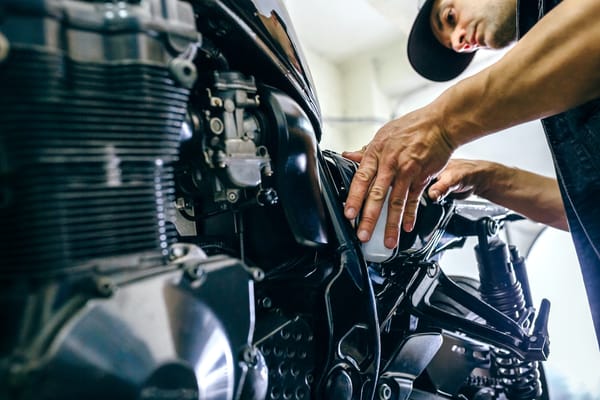
If your battery has removable caps, carefully check the electrolyte levels in each cell. If the levels are low, use distilled water to bring them up to the recommended level.
Avoid using tap water or other non-distilled water, as they may contain minerals that can harm the battery.
4. Follow the manufacturer’s recommendations for charging
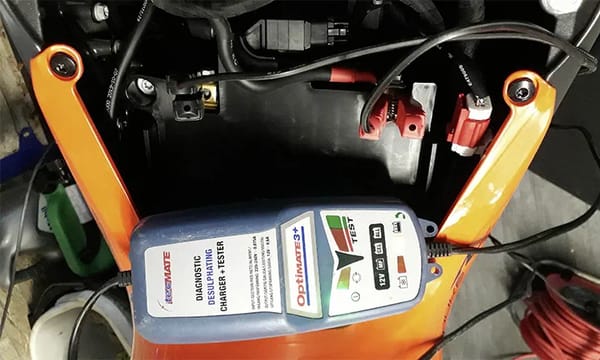
Use a charger specifically designed for motorcycle batteries and follow the instructions provided by the battery manufacturer.
Avoid overcharging the battery or leaving it connected to a charger for extended periods, as it can lead to damage.
5. Disconnect the battery during long periods of inactivity
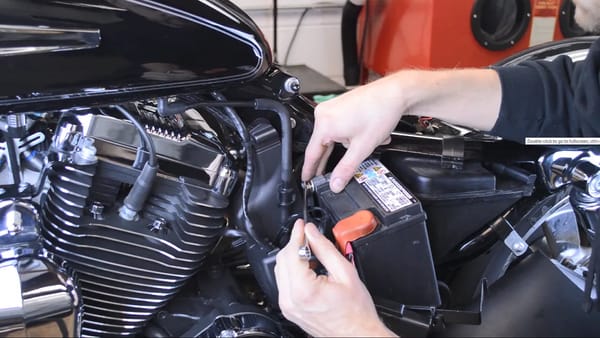
If you plan to leave your motorcycle unused for an extended period, it’s advisable to disconnect the battery.
This prevents any unnecessary drain and extends its overall lifespan.
6. Store the battery in a cool, dry place
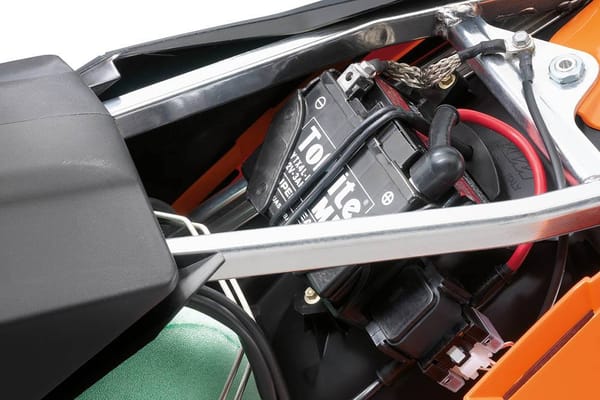
When not in use, store the battery in a location away from extreme temperatures, moisture, and direct sunlight.
Extreme heat or cold can negatively affect the battery’s performance and lifespan.
7. Use a battery tender or maintainer
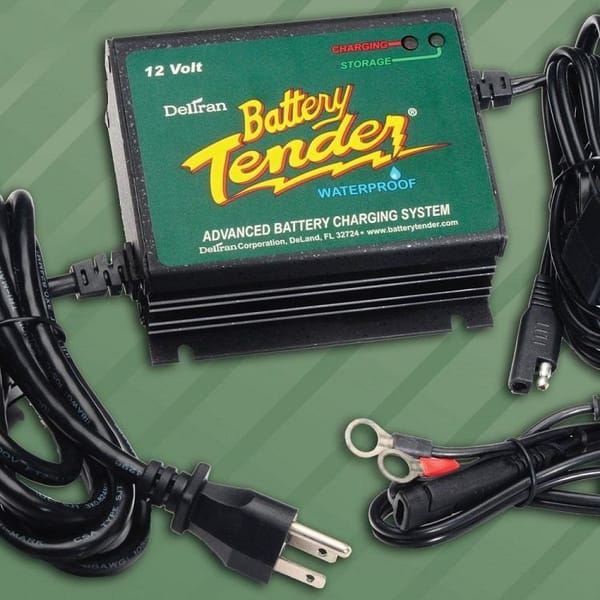
If your motorcycle will be inactive for a significant period, consider using a battery tender or maintainer.
These devices keep the battery charged at an optimal level and help prevent self-discharge.
8. Monitor the battery’s condition
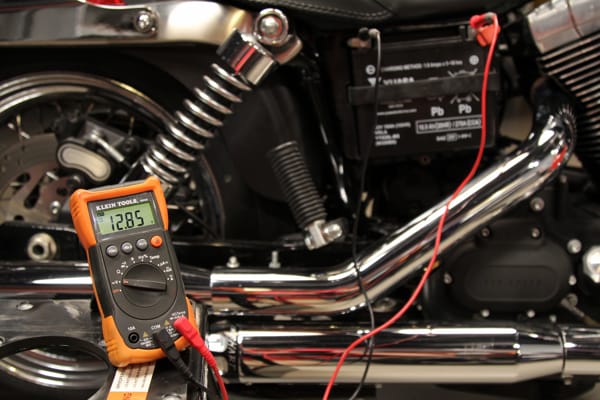
Regularly check for signs of battery deterioration, such as swelling, leakage, or a decrease in performance.
If you notice any of these issues, it may be time to replace the battery.
By following these maintenance tips, you can prolong the life of your motorcycle battery and ensure reliable performance when you need it.
Motorcycle Battery Dos and Don’ts
| Do | Don’t |
|---|---|
| Regularly inspect and clean the battery terminals. | Overcharge the battery or leave it connected to a charger for extended periods. |
| Keep the battery securely fastened to the motorcycle. | Allow the battery to remain discharged for an extended period. |
| Check the electrolyte levels regularly and top up with distilled water if needed. | Use tap water or any other non-distilled water to top up the battery. |
| Follow the manufacturer’s recommendations for charging the battery. | Use high-voltage chargers or jump-start the motorcycle with a car battery. |
| Disconnect the battery when the motorcycle is not in use for an extended period. | Ignore signs of battery deterioration such as swelling or leakage. |
| Store the battery in a cool, dry place when not in use. | Expose the battery to extreme temperatures or direct sunlight. |
| Use a battery tender or maintainer to keep the battery charged during long periods of inactivity. | Attempt to repair a damaged or leaking battery yourself. |
Motorcycle Charging Dos and Don’ts
| Do | Don’t |
|---|---|
| Use a charger specifically designed for motorcycles. | Use a charger that exceeds the recommended voltage or current for your battery. |
| Follow the manufacturer’s instructions for charging your motorcycle. | Attempt to charge a damaged or leaking battery. |
| Connect the charger to the battery before plugging it into an outlet. | Charge the battery in a poorly ventilated area or near flammable materials. |
| Ensure the charger is turned off before connecting it to the battery. | Leave the charger unattended for long periods of time. |
| Regularly check the charging progress and disconnect when fully charged. | Charge the battery in extreme temperatures or direct sunlight. |
| Maintain a clean and secure connection between the charger and battery. | Overcharge the battery or leave it connected to the charger for extended periods. |
| Use a smart charger that automatically adjusts the charging voltage. | Attempt to jump-start the motorcycle with a charger not designed for that purpose. |
Motorcycle Storage Dos and Don’ts
| Do | Don’t |
|---|---|
| Clean the motorcycle thoroughly before storing it. | Leave the motorcycle dirty or covered in mud before storage. |
| Apply a protective coat of wax or corrosion inhibitor to the body. | Store the motorcycle with a near-empty fuel tank. |
| Check and inflate the tires to the recommended pressure. | Leave the motorcycle exposed to the elements without a cover. |
| Change the oil and filter before long-term storage. | Store the motorcycle with the battery connected and no maintenance. |
| Add a fuel stabilizer to the tank and run the engine briefly to distribute it. | Park the motorcycle on an uneven or unstable surface. |
| Disconnect the battery or use a battery maintainer during storage. | Store the motorcycle in a humid or damp environment. |
| Place the motorcycle on a center stand or use a paddock stand. | Neglect regular inspections and maintenance during the storage period. |
| Cover the motorcycle with a breathable, waterproof cover. | Start the motorcycle periodically without proper warm-up and maintenance. |
Motorcycle Battery Fluid Dos and Don’ts
| Do | Don’t |
|---|---|
| Wear protective gloves and safety glasses when handling battery fluid. | Ingest or inhale battery fluid. |
| Use distilled water to top up the battery fluid if the levels are low. | Add other additives or chemicals to the battery fluid. |
| Add water to the battery cells before charging if the fluid levels are low. | Overfill the battery cells, exceeding the recommended fluid level. |
| Follow the manufacturer’s instructions for checking and maintaining battery fluid levels. | Use tap water or any other non-distilled water to top up the battery fluid. |
| Keep the battery fluid levels within the recommended range. | Allow the battery fluid to become excessively low or dry. |
| Inspect the battery for any signs of fluid leakage or corrosion. | Ignore signs of battery fluid leakage or corrosion. |
| Clean any battery fluid spills or corrosion with a baking soda and water solution. | Dispose of battery fluid or related materials improperly. |
| Dispose of battery fluid and related materials at designated recycling or disposal facilities. | Pour battery fluid down drains or onto the ground. |
FAQ
When To Replace Motorcycle Battery?
Here are some indicators for when to replace your motorcycle battery: Age: Replace after 2-5 years, Slow starting or multiple attempts, Dim lights or electrical issues, Frequent jump-starts, Swelling, leakage, or physical damage, Inability to hold a charge, Failed load testing, If you observe these signs, it’s likely time to replace your motorcycle battery.
How Do I Keep My Motorcycle Battery Healthy?
To keep your motorcycle battery healthy:
Ride regularly to keep it charged, Use a battery tender for long periods of inactivity, Keep terminals clean and secure, Maintain proper electrolyte levels with distilled water, Charge correctly and avoid overcharging, Store in a cool, dry place, Check for signs of deterioration, Secure the battery to minimize vibrations, By following these tips, you can maintain a healthy motorcycle battery.
How Often Should You Charge Motorcycle Battery?
Charge your motorcycle battery at least once a month to prevent discharging and maintain its health.
Follow the manufacturer’s instructions for optimal charging.
Originally posted 2023-07-04 11:30:43.
